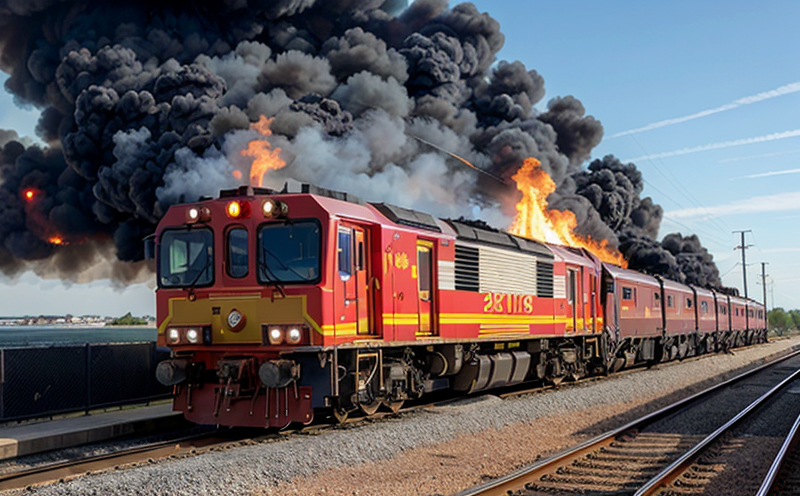Thermal Aging Impact on Railway Material Flammability
The thermal aging of materials used in railway applications is a critical consideration for ensuring the safety and reliability of transport systems. As temperatures fluctuate over time, materials can degrade, affecting their physical properties, including flammability. This section will delve into the impact of thermal aging on the flammability of materials specifically used in railway applications.
Thermal aging refers to the process by which materials undergo chemical and physical changes when exposed to elevated temperatures for extended periods. These changes can lead to a decrease or increase in material properties, depending on the nature of the materials involved. In the context of railway safety testing, understanding these effects is crucial because many components within railway systems are designed to withstand extreme environmental conditions.
The flammability of materials used in railways must comply with stringent international standards such as ISO 13943 and ASTM E606. These standards define acceptable limits for material properties that ensure safe operation under various temperature ranges. Railways require robust, non-flammable materials to prevent fires that could lead to catastrophic failures.
To evaluate the impact of thermal aging on flammability, tests are conducted using controlled environments that simulate real-world scenarios. This includes exposing specimens to temperatures and durations relevant to railway applications. The testing process involves several key steps:
- Specimen preparation: Materials used in railways need to be cut into standard sizes suitable for testing.
- Initial flammability measurement: Flammability is assessed using tests like the Vertical Burning Test (ASTM E647).
- Thermal aging process: Specimens are subjected to high temperatures over extended periods, simulating real-world conditions they might encounter during their service life.
- Post-aging flammability measurement: After thermal aging, specimens undergo another round of flammability tests to compare with initial results.
The data collected from these tests provides insights into how different materials behave under thermal stress. This information is invaluable for railway manufacturers and designers who need to select appropriate materials that maintain their safety attributes throughout the service life of a railway system.
Understanding the effects of thermal aging on flammability helps in optimizing material selection, ensuring compliance with regulations, and enhancing overall safety. By incorporating these insights into design processes, railways can achieve higher levels of reliability and reduce the risk of fires caused by aged materials.
In summary, thermal aging significantly impacts the flammability of materials used in railway applications. Conducting thorough testing helps identify potential risks early on, allowing for necessary adjustments to material selection and design practices. This ensures that rail systems remain safe and reliable under challenging conditions.
Benefits
The benefits of understanding the thermal aging impact on railway materials are numerous and far-reaching, particularly for those involved in quality management, compliance, research and development (R&D), and procurement. Here’s how this knowledge impacts various stakeholders:
- Quality Managers: By knowing which materials remain stable under thermal stress, quality managers can ensure consistent product performance throughout the lifecycle of railway systems.
- Compliance Officers: Compliance officers gain assurance that their products meet stringent international standards like ISO 13943 and ASTM E606, ensuring legal compliance and safer operations.
- R&D Engineers: R&D engineers can innovate by selecting materials that not only meet current standards but also anticipate future challenges related to thermal aging.
- Procurement Teams: Procurement personnel can source high-quality raw materials that are less prone to degradation, thereby reducing maintenance costs and extending the operational life of railway systems.
In essence, this service provides critical information that supports decision-making processes across multiple departments within an organization. It fosters a culture of continuous improvement aimed at enhancing safety standards in railway operations worldwide.
Quality and Reliability Assurance
The process of ensuring quality and reliability in railway materials subjected to thermal aging involves rigorous testing methods and adherence to international standards. Here are some key aspects that contribute to maintaining high-quality assurance:
- Standard Compliance: All tests conducted follow recognized standards such as ISO 13943 and ASTM E606, ensuring consistent results across different laboratories.
- Consistent Testing Conditions: Controlled environments replicate real-world conditions to provide accurate data on material behavior over time.
- Data Analysis: Advanced analytical techniques are employed to interpret test results accurately, providing actionable insights for manufacturers and designers.
- Safety Certifications: Materials that pass these rigorous tests can be certified as safe for use in railway applications, enhancing overall safety measures.
The combination of these factors ensures that only the most reliable materials are used in railway systems. This not only improves operational efficiency but also contributes significantly to public safety by minimizing risks associated with material failures due to thermal aging.
Customer Impact and Satisfaction
The impact of this service extends beyond just the technical aspects; it directly influences customer satisfaction through improved product reliability and safety. Here’s how:
- Safety Enhancements: Customers benefit from safer railway systems where materials are less likely to catch fire, reducing the risk of accidents.
- Increased Durability: By selecting materials that withstand thermal aging, customers enjoy longer-lasting products with reduced maintenance needs.
- Compliance Assurance: Meeting international standards ensures that customers adhere to legal requirements, thus avoiding potential fines or penalties.
- Enhanced Reputation: Providing reliable and safe railway systems enhances the reputation of both manufacturers and suppliers among their clients.
Overall, this service plays a pivotal role in enhancing customer satisfaction by delivering products that are not only compliant but also superior in terms of performance and longevity. This approach ultimately leads to stronger relationships between suppliers and customers, fostering trust and loyalty within the industry.





